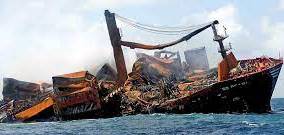
Souvenons-nous. Il y a presque 7 mois, nous rapportions le récit de la pire catastrophe environnementale qu’a connu le Sri Lanka. Le navire X-Press Pearl s’échouait non loin des cotes du pays laissant échapper une multitudes de produits toxiques dans les eaux. Une catastrophe écologique majeure s’en est suivie. Rappel des faits et ou en sommes nous aujourd’hui .
Il est visible sur les images satellites au large des côtes du Sri Lanka : un mince film gris qui serpente à trois kilomètres en mer avant de disparaître dans les vagues.
Des bouées de marquage ont été déployées autour de la périphérie de X-Press Pearl pour créer une zone de sécurité de 50 mètres autour de l’épave.
La nappe est un rappel viscéral de ce que les observateurs disent être une catastrophe environnementale au ralenti – l’une des pires de l’histoire du pays – et de l’effort gigantesque qui sera nécessaire pour le nettoyer.
« Il s’agit de la plus grande catastrophe environnementale qui a frappé le Sri Lanka depuis le tsunami de 2004 dans l’océan Indien », a déclaré Thummarukudyil Muraleedharan, directeur des opérations de la Direction de la gestion des crises du Programme des Nations Unies pour l’environnement (PNUE).
Thummarukudyil fait partie de plus d’une demi-douzaine d’experts du PNUE conseillant le gouvernement sri-lankais sur la façon de contenir les retombées toxiques dues au naufrage du X-Press Pearl, qui transportait 81 conteneurs de produits dangereux lorsqu’il a coulé en juin, selon son propriétaire, X-Press Feeders. La cargaison du navire comprenait 25 tonnes d’acide nitrique, 348 tonnes de pétrole et, selon des estimations indépendantes, jusqu’à 75 milliards de petites pastilles de plastique connues sous le nom de nurdles qui ont créé une marée noire historique ; une crise qui pourrait affliger le Sri Lanka pendant des années.
« C’est un navire toxique », a déclaré Hemantha Withanage, directrice exécutive du Centre pour la justice environnementale du Sri Lanka, un groupe de défense. « Ce sera un désastre de longue date. »
Les membres de l’équipage ont d’abord remarqué de la fumée provenant de la cale du X-Press Pearl le 20 mai, alors que le navire était ancré au large de Colombo, la capitale du Sri Lanka. Au cours des deux semaines suivantes, les équipes de pompiers ont combattu un enfer déchaîné ponctué d’au moins deux explosions majeures. Alors que le navire coulait lentement – il faudra attendre le 17 juin avant qu’il ne touche le fond marin – de forts courants ont ramassé des conteneurs d’expédition et les ont éparpillés le long de la côte du Sri Lanka.
Un conteneur a fait surface à plus de 100 kilomètres au sud de l’épave, recouvrant de nurdles les principales plages touristiques près de la station balnéaire de Galle, dans le sud-ouest du pays.
« C’était comme une bombe à retardement», a déclaré Hassan Partow, directeur de programme au Service de la gestion post-conflit et des catastrophes du PNUE.
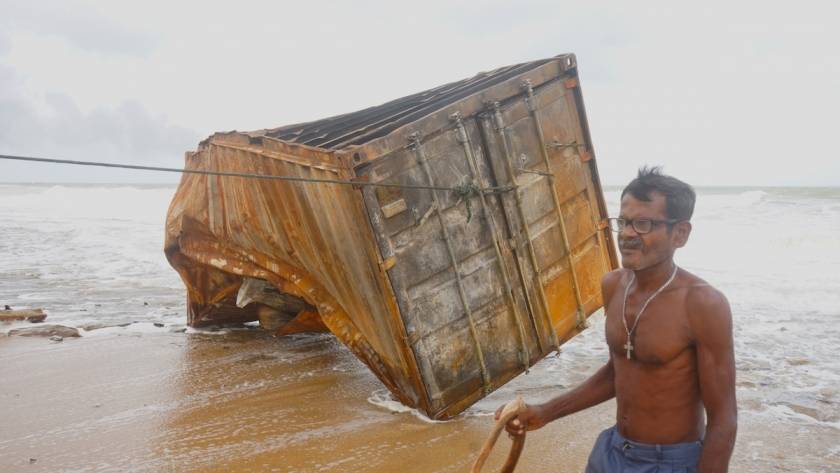 Un conteneur d’expédition carbonisé, l’un des plus de 1 400 à bord du X-Press Pearl, est tiré d’une plage de l’ouest du Sri Lanka. Les conteneurs ont fait surface jusqu’à 100 km de l’endroit où le navire a coulé. Photo: Autorité de protection de l’environnement marin du Sri Lanka
Un conteneur d’expédition carbonisé, l’un des plus de 1 400 à bord du X-Press Pearl, est tiré d’une plage de l’ouest du Sri Lanka. Les conteneurs ont fait surface jusqu’à 100 km de l’endroit où le navire a coulé. Photo: Autorité de protection de l’environnement marin du Sri Lanka
Pollution plastique
Pour les Sri-Lankais, les petites pastilles de plastique, qui ont à peu près la taille d’une lentille, ont été le signe le plus visible du naufrage de la perle X-Press.
En utilisant des données accessibles au public, Withanage estime que le navire contenait 70 à 75 milliards de granulés individuels. Partow a déclaré que la catastrophe est la plus grande libération de nurdles dans l’océan jamais signalée.
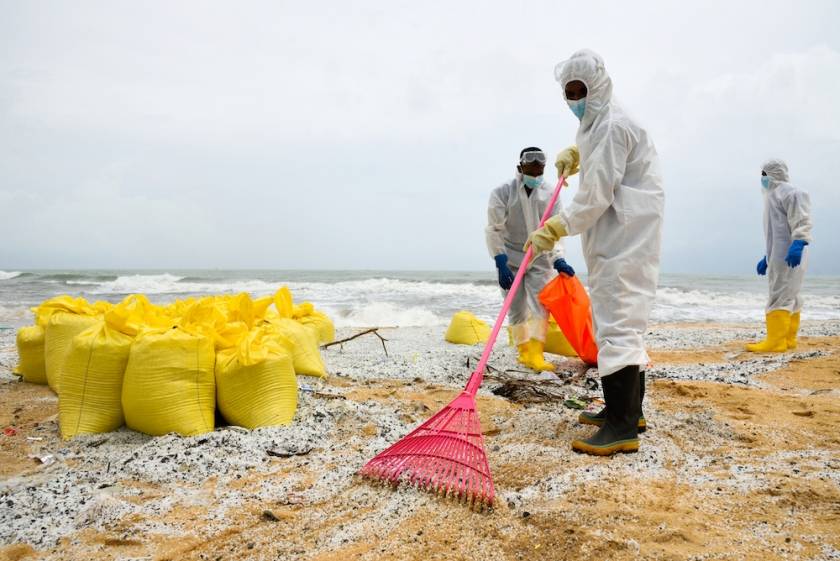 Les équipes collectent des granulés de plastique de la taille d’une lentille sur une plage sri-lankaise. Selon une estimation, le X-Press Pearl transportait quelque 75 milliards de ces granulés lorsqu’il a coulé au large des côtes de Colombo. Photo : Shutterstock/Ruwan Walpola
Les équipes collectent des granulés de plastique de la taille d’une lentille sur une plage sri-lankaise. Selon une estimation, le X-Press Pearl transportait quelque 75 milliards de ces granulés lorsqu’il a coulé au large des côtes de Colombo. Photo : Shutterstock/Ruwan Walpola
Le plastique a inondé les plages autour de Colombo. L’une d’elles, Sarukkuwa, était recouverte de piles de plastique d’un mètre de hauteur. Les nurdles sont également apparues dans les branchies et les entrailles des poissons. Les pêcheurs locaux, qui ont été exclus des abondantes zones de pêche autour de Colombo, ont accusé les nurdles d’avoir tué la vie marine, bien que cette affirmation fasse toujours l’objet d’une enquête par des scientifiques sri-lankais. Withanage a déclaré que des granulés ont également été trouvés dans un sanctuaire de tortues à 300 km au nord de Colombo.
Au fil du temps, les granulés, qui mettront jusqu’à 1 000 ans à se désintégrer, pourraient s’accumuler dans la chaîne alimentaire, rendant malades les poissons et potentiellement les humains, a déclaré Withanage. « Quand il s’agit de l’environnement, chaque nurdle en plastique est un désastre. »
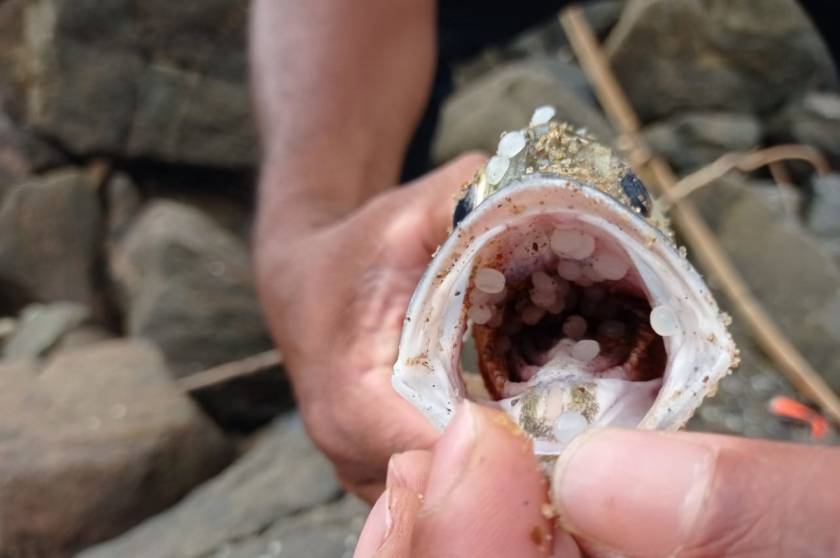 Les pêcheurs locaux ont trouvé des granulés de plastique dans les branchies et les boyaux des poissons, bien que les chercheurs soient encore en train de déterminer si le plastique est responsable de la mort des poissons. Photo: Autorité de protection de l’environnement marin du Sri Lanka
Les pêcheurs locaux ont trouvé des granulés de plastique dans les branchies et les boyaux des poissons, bien que les chercheurs soient encore en train de déterminer si le plastique est responsable de la mort des poissons. Photo: Autorité de protection de l’environnement marin du Sri Lanka
Pire encore, de nombreux granulés ont été carbonisés, ce qui les a fait s’effriter en une poudre potentiellement toxique lorsqu’ils sont mis en mouvement.
« Ce n’étaient pas seulement des granulés vierges », a déclaré Partow. « Environ la moitié ont été brûlés, donc le public n’est pas au courant de leur toxicité. »
Immédiatement après le naufrage du X-Press Pearl, des centaines de membres de la marine, de l’armée de l’air et des garde-côtes sri-lankais ont été déployés dans le cadre d’une opération de nettoyage massive supervisée par l’Autorité de protection du milieu marin. Travaillant jour et nuit sous les restrictions strictes de confinement liées à la COVID-19, ils ont jusqu’à présent collecté plus de 53 000 sacs de granulés, de plastique brûlé et d’autres débris mélangés à du sable. La petite taille des granulés de plastique signifie que beaucoup ont dû être tamisés à la main.
Il n’y a aucun moyen, cependant, de nettoyer les granulés de plastique encore dans l’océan.
« Ce qui est dans la mer pourrait être là pendant longtemps », a déclaré Thummarukudyil.
Une infusion toxique
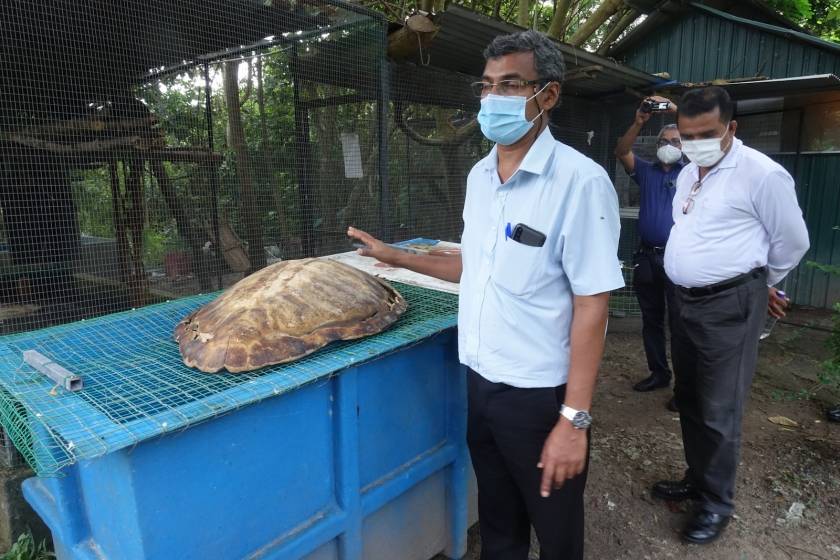 Les experts craignent que les produits chimiques de la perle X-Press n’aient ébouillanté la vie marine. Les autorités sri-lankaises ont trouvé des carcasses de tortues avec ce qu’ils soupçonnent être des marques de brûlure, bien que les recherches se poursuivent. Photo : PNUE
Les experts craignent que les produits chimiques de la perle X-Press n’aient ébouillanté la vie marine. Les autorités sri-lankaises ont trouvé des carcasses de tortues avec ce qu’ils soupçonnent être des marques de brûlure, bien que les recherches se poursuivent. Photo : PNUE
Il semble également probable qu’au moins une partie de l’acide nitrique hautement corrosif à bord du X-Press Pearl se soit infiltrée dans l’océan. Les experts craignent qu’il n’ait ébouillanté la vie marine dans un récif corallien voisin.
Le 22 juin, les données du Wild Life Department ont montré que 107 tortues mortes, dont 57 étaient des espèces d’Olive Ridley, 19 étaient des tortues vertes, 02 hawksbill, une tortue luth et d’autres n’étaient pas identifiées à l’époque. Au moins trois anguilles ont également été emportées sur le rivage. Le 7 juillet, le gouvernement sri-lankais a confirmé que 176 tortues, quatre baleines et 20 dauphins étaient morts et échoués sur les plages sri-lankaises. La cause du décès ne peut pas être attribuée avec certitude au seul accident de X-Press Pearl, cependant, un nombre aussi élevé de décès est sans précédent, même pendant la saison de la mousson.
Alors que l’acide nitrique s’est probablement dissipé dans l’océan, les préoccupations se sont maintenant tournées vers un autre produit chimique toxique transporté par la perle X-Press: la résine époxy. Environ 9 800 tonnes métriques d’époxy se trouvaient à bord et les experts craignent que s’il était sous forme liquide toxique – par opposition à sous forme solide – il pourrait se propager le long de la côte sri-lankaise.
Le navire contenait également une cocktail d’autres produits chimiques, y compris du méthanol, de l’huile pour engrenages, du liquide de frein et de l’urée, ainsi que des batteries au plomb, au cuivre et au lithium, selon Withanage.
La question du pétrole
La quantité exacte de matières toxiques qui reste dans la cale du navire ou dans des conteneurs au fond de l’océan reste inconnue. La mousson annuelle du Sri Lanka, associée à un confinement lié à la COVID-19 à l’échelle du pays, a entravé les efforts de sauvetage.
Le propriétaire du navire, X-Press Feeders, a déclaré qu’une grande partie de la cargaison aurait pu être brulée dans l’incendie, y compris le carburant noir ressemblant à de la mélasse qui alimentait la X-Press Pearl. Mais l’équipe de l’ONU pense que même si le pétrole a été brûlé, il est peu probable qu’il se soit évaporé. Au lieu de cela, il serait probablement transformé en un mélange plus visqueux.
« Nous devrions supposer que le pétrole est toujours là », a déclaré Thummarukudyil. Le navire, a-t-il ajouté, transportait suffisamment de pétrole pour couvrir toute la côte ouest du Sri Lanka. « Le potentiel est là pour que ce soit bien pire que ce que nous avons déjà vu. »
Intervention en cas de catastrophe
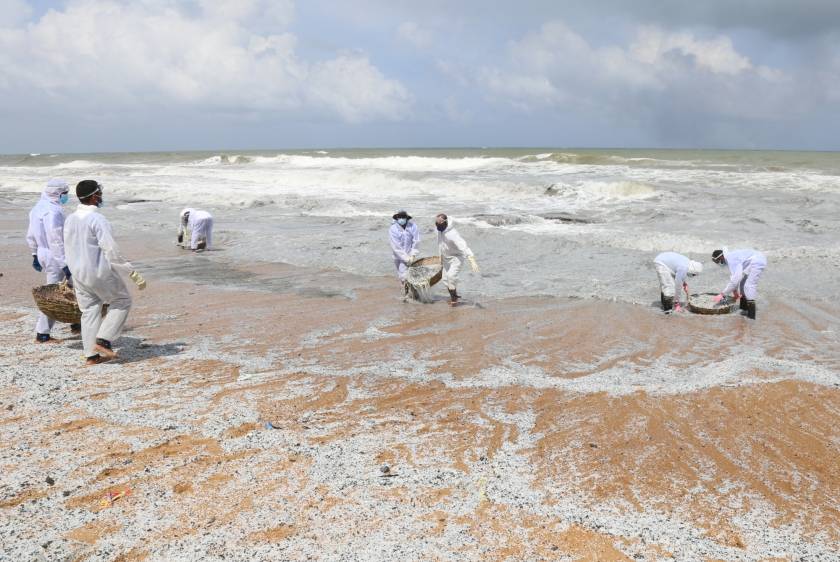 La petite taille des granulés de plastique signifie que certains doivent être collectés et tamisés à la main un processus laborieux. Jusqu’à présent, le Sri Lanka a rempli 53 000 sacs à ordures de pellets, de sable et d’autres débris. Photo: Autorité de protection de l’environnement marin du Sri Lanka
La petite taille des granulés de plastique signifie que certains doivent être collectés et tamisés à la main un processus laborieux. Jusqu’à présent, le Sri Lanka a rempli 53 000 sacs à ordures de pellets, de sable et d’autres débris. Photo: Autorité de protection de l’environnement marin du Sri Lanka
Le personnel du PNUE travaillant sur le naufrage du X-Press Pearl fait partie d’une unité d’intervention en cas de catastrophe gérée conjointement par le Bureau de la coordination des affaires humanitaires des Nations Unies (OCHA). L’unité a aidé à négocier un accord entre le gouvernement sri-lankais et le propriétaire du X-Press Pearl pour contenir un éventuel déversement de pétrole en mer et nettoyer le rivage. Du matériel spécialisé, y compris des barrages gonflables conçus pour piéger le pétrole, est arrivé à Colombo le 2 juillet.
« Les Nations Unies aident le gouvernement du Sri Lanka à faire face à la catastrophe du MV X-Press Pearl », a déclaré la Coordonnatrice résidente des Nations Unies au Sri Lanka, Hanaa Singer-Hamdy. « Nous coordonnons les efforts internationaux et mobilisons nos partenaires pour assurer une réponse cohérente et efficace à la crise (et) assurer la prévention de telles catastrophes à l’avenir. »
Le PNUE a appelé le propriétaire et l’assureur du navire à élaborer ce que Partow a appelé une feuille de route « examinée par des pairs et approuvée par le gouvernement » pour retirer le X-Press Pearl et les conteneurs errants dans les fonds marins, affirmant qu’ils constituent le risque le plus immédiat de pollution.
« Ce plan doit être élaboré maintenant afin que, lorsque les conditions le permettront, le navire puisse être retiré et correctement déclassé », a déclaré Partow.
Une équipe de 40 experts et scientifiques sur le terrain, coprésidée par le professeur Ajith de Alwis, doyen de la faculté des études supérieures de l’Université Moratuwa et le professeur Prshanthi Gunawardena du Département des sciences forestières et de l’environnement de l’Université de Sri Jayewardenepura, a été chargée d’estimer les dommages environnementaux.
Une assistance a été fournie par 14 organismes gouvernementaux, dont le Département de l’analyste gouvernemental, l’Autorité centrale de l’environnement et le Département de la conservation de la faune. En outre, une assistance en laboratoire a été obtenue auprès de pays étrangers, notamment le Royaume-Uni, l’Australie et la France.
En ce qui concerne l’environnement, chaque nurdle en plastique est un désastre.
Hemantha Withanage, Centre pour la justice environnementale
Pour Withanage, le temps presse. « C’est une juste une affaire pour eux », a-t-il déclaré à propos de la société de sauvetage embauchée pour relever le navire ainsi que le propriétaire du navire. « Mais pour nous, c’est notre environnement. Tant que le navire est là, la contamination est là. »
Le PNUE remettra un rapport final sur la catastrophe au gouvernement sri-lankais la semaine prochaine. Il contiendra des recommandations pour le nettoyage et des suggestions sur la façon dont le Sri Lanka, un pays en lice pour devenir une plaque tournante majeure du transport maritime, peut faire face à de futures catastrophes maritimes. Partow a déclaré que le PNUE se tiendrait également à l’écart pour conseiller le Sri Lanka sur la surveillance environnementale à plus long terme.
Scène fantomatique
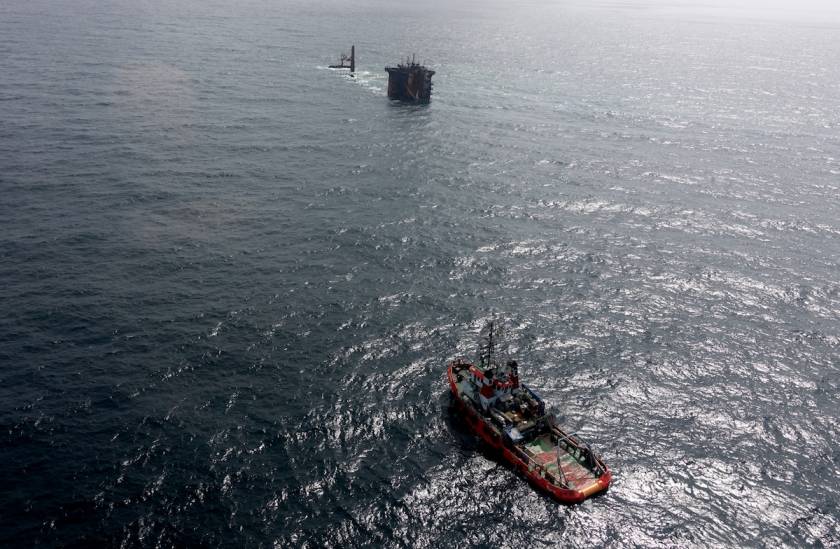 Un navire gardien fait le tour du X-Press Pearl 24 heures sur 24, surveillant l’épave à la recherche d’un déversement d’hydrocarbures. La perle X-Press, ravagée par un incendie qui a duré des semaines, est assise dans 21 mètres d’eau. Le PNUE et le gouvernement sri-lankais poussent le propriétaire du navire à renflouer et à remorquer le navire. Photo : PNUE
Un navire gardien fait le tour du X-Press Pearl 24 heures sur 24, surveillant l’épave à la recherche d’un déversement d’hydrocarbures. La perle X-Press, ravagée par un incendie qui a duré des semaines, est assise dans 21 mètres d’eau. Le PNUE et le gouvernement sri-lankais poussent le propriétaire du navire à renflouer et à remorquer le navire. Photo : PNUE
Aujourd’hui, le navire est en grande partie submergé dans 21 mètres d’eau, la partie élevée et quelques grues carbonisées restent au dessus des vagues. Un navire gardien l’entoure 24 heures sur 24, en surveillant la fuite d’huile.
Partow, qui a visité l’épave en bateau et en hélicoptère, a vu des granulés de plastique mélangés à de l’huile flotter dans les vagues autour du navire. Des taches brunes de pétrole entourées d’un éclat gris s’étendaient sur deux à trois kilomètres dans la mer.
APPARENTÉ
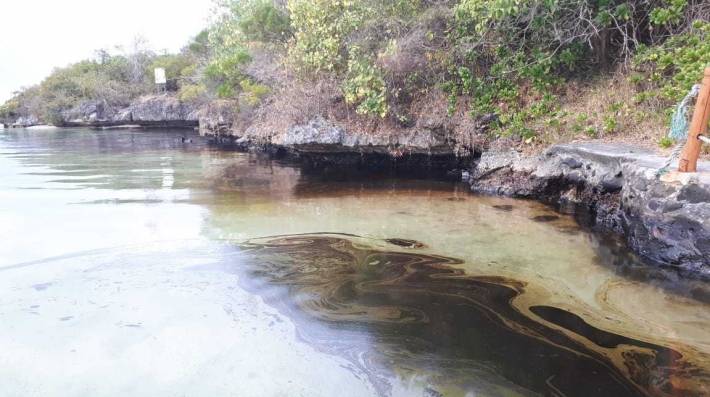
HISTOIRE
Il a décrit le navire de 186 mètres de long, qui est entré en service en février, comme une « radiation ».
Thummarukudyil a passé 18 ans à répondre aux marées noires dans le monde entier. Lorsqu’on lui a demandé si le X-Press Pearl était la pire catastrophe écologique maritime qu’il ait vue, il a fait une pause.
« Il y a encore beaucoup de produits chimiques là-bas », a-t-il déclaré. « Cette histoire n’est pas encore terminée. »
Publié le 22/01/2022 12:02

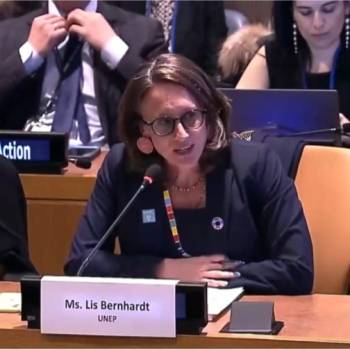






Commentaires